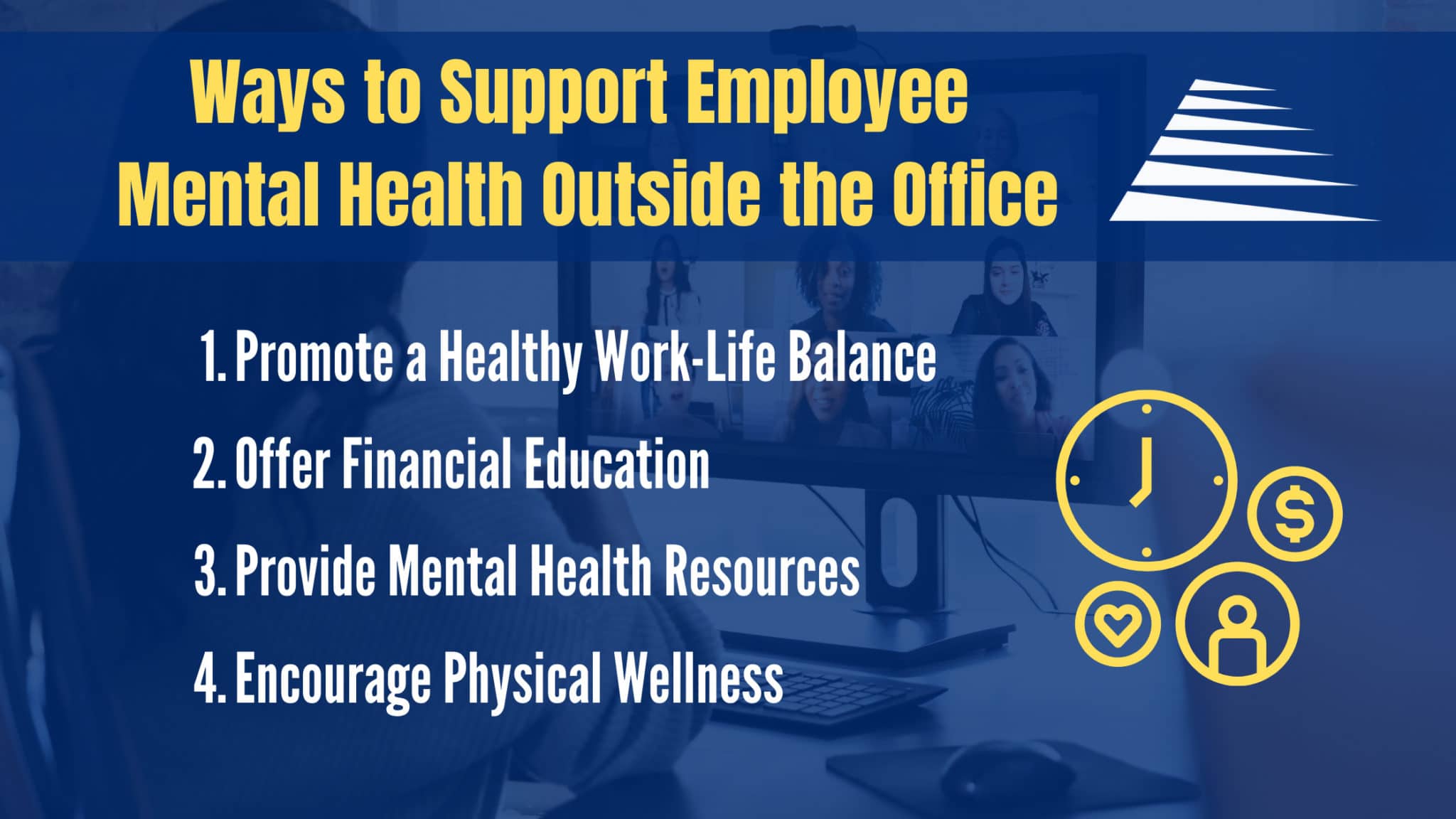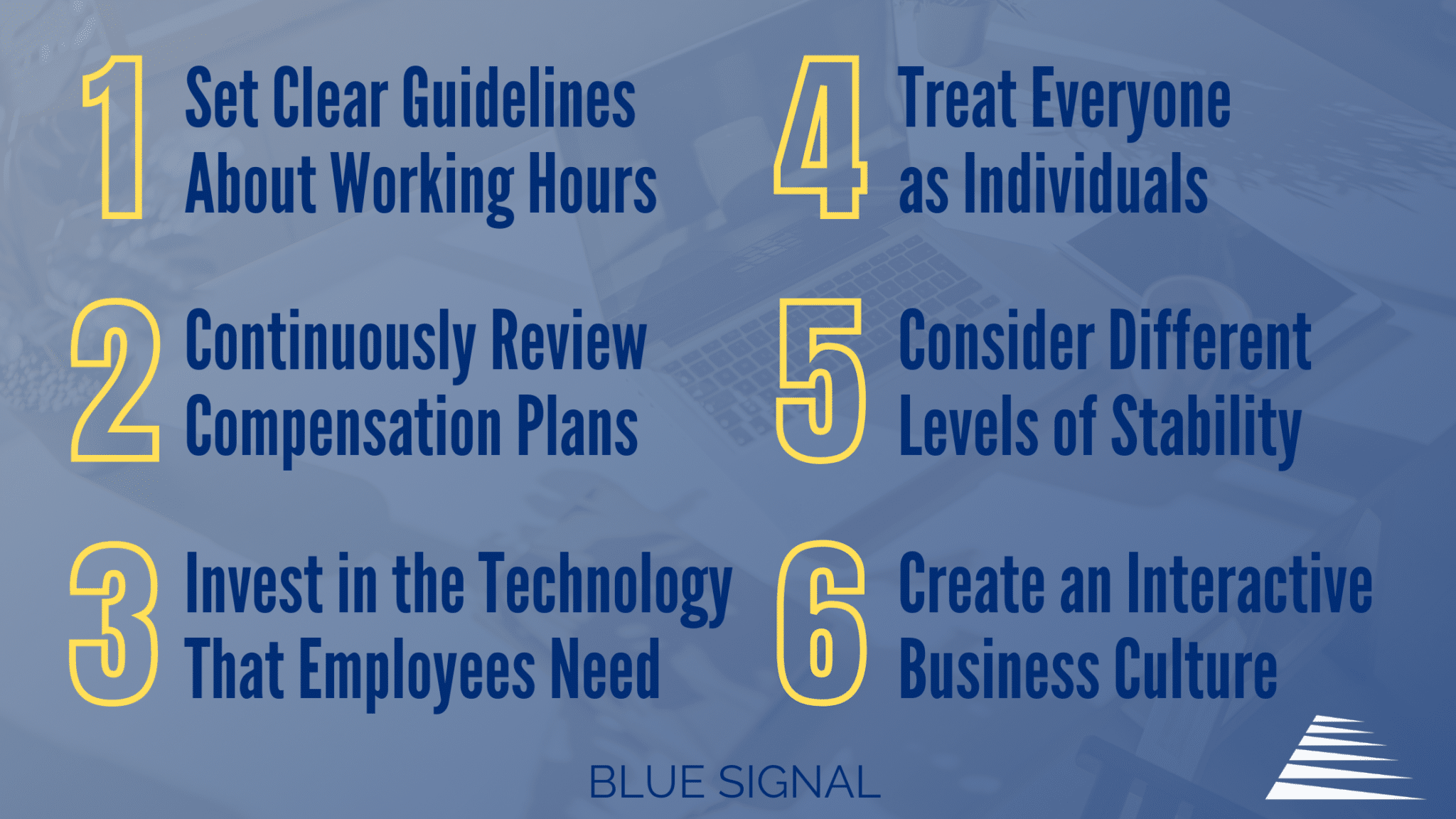Mental health has become increasingly important, both inside and outside of the workplace. Along with employee satisfaction, mental health can impact your team’s performance and if not taken care of, can lead to burnout, stress, and turnover. As evidenced by the ‘Great Resignation’ of 2021, people are more willing than ever to quit their jobs to find companies that support their needs. Along with ensuring your employees are taken care of during the workday, you should also take steps to support their mental health outside of the office. This can not only boost your team’s overall satisfaction and engagement with your company, but it can also result in increased productivity and retention. Here are a few ways you can show your support.

Promote a Healthy Work-Life Balance
An important part of fostering strong mental health outside of the office is allowing your employees enough time to enjoy themselves aside from work tasks. According to a recent report from Mental Health America, 9 in 10 employees say their workplace stress affects their mental health. Making sure a healthy work-life balance is part of your company’s values can help create a positive team culture and ensure your employees aren’t letting their work responsibilities overwhelm their personal lives.
A simple way to do this is by offering flexible schedules and allowing employees to choose their own hours – in moderation of course. This practice has become increasingly popular and common after many companies went remote due to the COVID-19 pandemic. Although this may seem like a small change, it can make a big difference on your team’s mental health and wellbeing. Especially if much of your work is self-motivated, this flexibility allows your team to work when they’re most productive, giving them the ability to focus on their personal needs and mental health throughout the day. For instance, some employees may want to work earlier in the day so they can pick up their kids from school, while others may want to work later to account for morning exercise. While it may seem scary to loosen the reins, you can always set a few guidelines. Setting parameters such as designated working periods and regular mandatory meeting times can establish more consistency.
Along with offering flexible schedules, it’s important to encourage employees to use their vacation time. Beyond that, make sure they aren’t contacted about work during their time off. Allowing your team to truly unplug and relax during their well-deserved vacation days will ensure they have enough time to focus on their personal needs without having to worry about work.
Additionally, allowing employees to flex their working hours for appointments and other responsibilities is another valuable practice that can improve their mental health. Letting your employees make up the missed time for menial tasks rather than using their paid time off can reduce scheduling stress and allow them to make better use of their vacation time. Overall, promoting a strong work-life balance can give your employees more time to focus on their mental health and personal needs. This can also help attract new employees as this is an important benefit that many job seekers value when researching companies.
Offer Financial Education
Another way to support your team’s mental health outside of the workplace is offering financial education. Finances can be a major cause of anxiety with 73% of Americans ranking finances as the number one cause of stress in their lives. Although this hardship may not be directly related to work, it can negatively impact your team’s focus and productivity – especially if they’re in debt. Giving your employees the resources they need to educate themselves and relieve their financial stress can help them feel more secure, resulting in improved mental health.
Although your company may offer financial benefits, your employees may not know how to effectively utilize them. Both younger and older employees have differing financial challenges to face, such as student loan debt, mortgage payments, saving for retirement, and more. By improving your team’s financial literacy, you can help them use their paychecks to the fullest and create a better quality of life for themselves. Providing resources on advanced financial practices like how to get a home equity loan to pay off high-interest debt or how to earn passive income through real estate investing can give your employees more stability and confidence with their money, allowing them to relieve stress. You can educate your employees through many outlets, like paying for an online course, providing reading materials, or inviting a guest speaker to discuss more specific financial topics your team may be interested in. No matter what format you choose, offering financial education resources can show your employees you value their wellbeing outside of work.
Provide Mental Health Resources
According to a Harvard Business Review study, 76% of employees reported at least one symptom of a mental health condition in the past year. Mental health conditions can take many forms and can vary from person to person, making it difficult for leadership and coworkers to determine effective ways to help. Some employees may not feel comfortable talking about these issues in the workplace, which is why it’s important to provide mental health resources that your team can access on their own and at their own convenience.
One popular way to do this is through an employee assistance program (EAP), which is an employee benefit program that assists your team with personal or work related problems. This program is free for your employees to use so they don’t have to worry about a financial burden. It also provides confidential support that your employees may feel more comfortable using. An EAP offers access to counselors and other mental health professionals along with additional resources employees can use to support their mental health and wellbeing. Even if you don’t use an EAP, providing mental health resources through online sources and other outlets can help your employees take care of themselves.
Encourage Physical Wellness
Mental and physical health often go hand in hand, as exercise has been proven to boost your mood by reducing symptoms of anxiety and depression. Along with other wellness initiatives, encouraging your employees to take care of their physical health is a great way to support their mental health. Especially as people spend more time at home due to the pandemic, there’s been an increased focus on staying active and healthy in these unique conditions.
However, certain fitness subscriptions can be pricey, and some employees may struggle to afford equipment needed to workout, which can prevent them from nurturing their physical and mental health. Giving your employees the tools they need to take care of themselves can show your appreciation and support for them outside of the office. This could be sponsoring a gym membership, paying for fitness classes, or offering a fitness stipend your employees can use for related expenses if your company is remote. No matter what you choose, your team will appreciate your effort to increase their quality of life.
An increased focus on employee mental health outside of the office may be just what your company needs to secure top talent in a competitive market. These practices can not only help your current employees feel valued and appreciated, but they can also help attract new candidates. Making sure you support your team’s mental health will set you up for long-term success and ensure your employees are taken care of.




